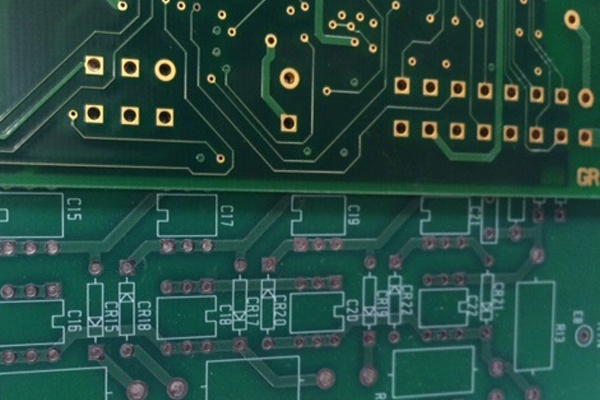As a contract manufacturer, say you receive a new circuit board part to assemble that is 6-layers with a high micro-via count, has blind and buried vias, and a lead free HASL finish. The circuit board laminate requirement for meeting the Restriction of Hazardous Substances, or RoHS compliance, is strictly Glass Transition Temperature(Tg) 170.
After assembly, there is a high fall-out with internal failures at the board level. Micro-section analysis reveals numerous delamination pockets, inner layer connection breaks, and overall laminate breakdown. If the laminate was Tg 170, or high Tg PCB material, why would this happen?

RoHS Compliancy is Not Just a Question of Tg Anymore
Features:
- High Thermal Performance
- Tg: 180°C (DSC) (Base Laminate)
- Td: 340°C (TGA at 5% wt loss)
- Low CTE for reliability
- T260: 60 minutes
- T288: >15 minutes
- Lead-free Compatible and RoHS Compliant
Impacts of Tg & Td Circuit Board Laminates
Tg impacts z-axis expansion and mechanical performance, which primarily relates to interconnect reliability. However, with the continuing increase in board technology, micro-vias, higher layer counts, heavier copper weights, blind/buried vias, mixed materials, and multiple surface finishes to pick from, further material thermal characteristics must be taken into consideration at the design stage.
Thermal Decomposition Temperature, Td, primarily impacts catastrophic laminate failure but does play a role in Plated Through Hole (PTH) reliability and performance in actual use post assembly.
Time to Delamination
Time to Delamination (T260/T288) is a test defined by the IPC under IPC-TM-650 Test Method 2.4.24.1. A test sample is incrementally raised in temperature 10°C/min to 260°C (or 288°C) and then dwells at 260°C (or 288°C). When an event occurs such as delamination, cracking, moisture release, stress relaxation, decomposition or a sudden movement, a sensor detects the change. The time in minutes from the start of the dwell time to the event at 260°C (or 288°C) is the time to delamination.
Coefficient of Thermal Expansion
The coefficient of thermal expansion (CTE) describes a number or percentage relating to how much a printed circuit board (PCB) expands as it is heated or cooled. The expansion is expressed in parts per million per degree celsius (ppm/°C). Typical FR4 has a CTE of 17 to 19ppm/C, which could be an issue when your chip package only has a CTE of 8 ppm/C.
Characteristics of Circuit Board Laminates
When a circuit board laminate datasheet is reviewed for all these characteristics, it must be understood that the parameters expressed are for the raw, fully cured, as received laminate. It does not reflect the exact parameters of a finished PCB. Every time a printed circuit board is exposed to high thermal temperatures it becomes damaged. This is the case not only for multi-layer pressing, but also for Lead-Free soldering applications, such as lead free HASL. Only then are the temperatures of the assembly processes introduced.
Traditional Tin /Lead alloys (Sn/Pb) melt at 183°C and are reflowed at a peak temperature of 210-235°C. Typical Tin / Silver / Copper alloys (Sn/Ag/Cu) melt at approximately 217°C and are reflowed at a peak temperature of 235-260 C. It is the higher peak reflow temperatures required for lead free solders that present the real challenges for laminate base materials.
Other thermal factors to consider:
- Low z-axis expansion is desirable for interconnect reliability. This can be improved through the use of “fillers”.
- Phenolic cured FR-4 systems are mechanically weaker than their traditional dicey cured FR-4 counterparts. The altered resin content of phenolic-cured materials may impact signal propagation delays and noise margins.
- Dicy-cured FR-4 materials begin to decompose at temperatures near 260°C, well within the typical temperature range of lead-free assembly processes. However, while modifying the resin components and cure agents, increase thermal performance, it can also potentially effect the process capability and electric properties of PCBs.
Conclusion
It is imperative with higher technology printed circuit boards that PCB designers take many more laminate characteristics into consideration than just Tg. It is also important that the assembler and circuit board manufacturer review the print notes carefully for called out laminate specifications such as Td, CTE, and IPC slash requirements.
















